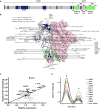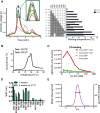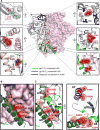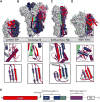A Universal Approach to Optimize the Folding and Stability of Prefusion-Closed HIV-1 Envelope Trimers
- PMID: 29642014
- PMCID: PMC6010203
- DOI: 10.1016/j.celrep.2018.03.061
A Universal Approach to Optimize the Folding and Stability of Prefusion-Closed HIV-1 Envelope Trimers
Abstract
The heavily glycosylated native-like envelope (Env) trimer of HIV-1 is expected to have low immunogenicity, whereas misfolded forms are often highly immunogenic. High-quality correctly folded Envs may therefore be critical for developing a vaccine that induces broadly neutralizing antibodies. Moreover, the high variability of Env may require immunizations with multiple Envs. Here, we report a universal strategy that provides for correctly folded Env trimers of high quality and yield through a repair-and-stabilize approach. In the repair stage, we utilized a consensus strategy that substituted rare strain-specific residues with more prevalent ones. The stabilization stage involved structure-based design and experimental assessment confirmed by crystallographic feedback. Regions important for the refolding of Env were targeted for stabilization. Notably, the α9-helix and an intersubunit β sheet proved to be critical for trimer stability. Our approach provides a means to produce prefusion-closed Env trimers from diverse HIV-1 strains, a substantial advance for vaccine development.
Keywords: ConC_base; HIV; SOSIP; X-ray structure; chronic; envelope protein; hybrid sheet; stabilization; transmitted/founder; vaccine.
Copyright © 2018 The Authors. Published by Elsevier Inc. All rights reserved.
Conflict of interest statement
These studies were funded by Janssen Vaccines and Prevention. L.R., D.T., D.v.M., S.B., N.M.S., A.K., I.J.M.B., H.S., and J.P.M.L. are employees at Janssen. L.R., D.T., N.M.S., A.K., and J.P.M.L. are inventors on an international patent application describing trimer stabilizing HIV envelope protein mutations. The remaining authors declare no competing interests.
Figures






Similar articles
-
Structure-Based Design of a Soluble Prefusion-Closed HIV-1 Env Trimer with Reduced CD4 Affinity and Improved Immunogenicity.J Virol. 2017 Apr 28;91(10):e02268-16. doi: 10.1128/JVI.02268-16. Print 2017 May 15. J Virol. 2017. PMID: 28275193 Free PMC article.
-
Immunogenicity of a Prefusion HIV-1 Envelope Trimer in Complex with a Quaternary-Structure-Specific Antibody.J Virol. 2015 Dec 30;90(6):2740-55. doi: 10.1128/JVI.02380-15. J Virol. 2015. PMID: 26719262 Free PMC article.
-
Structure-Guided Redesign Increases the Propensity of HIV Env To Generate Highly Stable Soluble Trimers.J Virol. 2015 Dec 30;90(6):2806-17. doi: 10.1128/JVI.02652-15. J Virol. 2015. PMID: 26719252 Free PMC article.
-
Stabilizing HIV-1 envelope glycoprotein trimers to induce neutralizing antibodies.Retrovirology. 2018 Sep 12;15(1):63. doi: 10.1186/s12977-018-0445-y. Retrovirology. 2018. PMID: 30208933 Free PMC article. Review.
-
The HIV-1 envelope glycoprotein structure: nailing down a moving target.Immunol Rev. 2017 Jan;275(1):21-32. doi: 10.1111/imr.12507. Immunol Rev. 2017. PMID: 28133813 Free PMC article. Review.
Cited by
-
HIV-1 Envelope Conformation, Allostery, and Dynamics.Viruses. 2021 May 7;13(5):852. doi: 10.3390/v13050852. Viruses. 2021. PMID: 34067073 Free PMC article. Review.
-
Contemporary HIV-1 consensus Env with AI-assisted redesigned hypervariable loops promote antibody binding.Nat Commun. 2024 May 9;15(1):3924. doi: 10.1038/s41467-024-48139-x. Nat Commun. 2024. PMID: 38724518 Free PMC article.
-
Development of a 3Mut-Apex-Stabilized Envelope Trimer That Expands HIV-1 Neutralization Breadth When Used To Boost Fusion Peptide-Directed Vaccine-Elicited Responses.J Virol. 2020 Jun 16;94(13):e00074-20. doi: 10.1128/JVI.00074-20. Print 2020 Jun 16. J Virol. 2020. PMID: 32295908 Free PMC article.
-
Efficiently cleaved HIV-1 envelopes: can they be important for vaccine immunogen development?Ther Adv Vaccines Immunother. 2020 Oct 8;8:2515135520957763. doi: 10.1177/2515135520957763. eCollection 2020. Ther Adv Vaccines Immunother. 2020. PMID: 33103053 Free PMC article. Review.
-
New Vaccine Design and Delivery Technologies.J Infect Dis. 2019 Apr 8;219(Suppl_1):S88-S96. doi: 10.1093/infdis/jiy745. J Infect Dis. 2019. PMID: 30715361 Free PMC article.
References
-
- Binley JM, Sanders RW, Clas B, Schuelke N, Master A, Guo Y, Kajumo F, Anselma DJ, Maddon PJ, Olson WC, Moore JP. A recombinant human immunodeficiency virus type 1 envelope glycoprotein complex stabilized by an intermolecular disulfide bond between the gp120 and gp41 subunits is an antigenic mimic of the trimeric virion-associated structure. J Virol. 2000;74:627–643. - PMC - PubMed
MeSH terms
Substances
Grants and funding
LinkOut - more resources
Full Text Sources
Other Literature Sources

